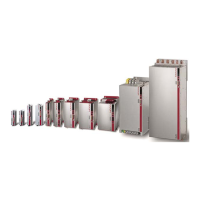6.1Cable
The MSD Servo Drive groups individual encoders (supported encoder interfaces)
into what are referred to as “encoder channels”. Within each encoder channel, a
maximum of one encoder can be active at any one time, meaning that the number of
encoder channels also defines the maximum number of encoders that can be active
simultaneously. The encoder channels are Ch1, Ch2, Ch3 and Ch4.
To select a specific encoder for a control level (e.g. for speed control), you must first
select an encoder channel for that control level, after which you will be able to select
a specific encoder for the selected channel.
The supported encoder interfaces are distributed among the four encoder channels
as follows:
Ch1:X7(Sin/Cos,TTL,cyclicalSSI,cyclicalEnDAT,etc.)(see Section
"Channel1:InterfaceX7"onpage56)
Ch2:X6(resolver,low-frequencySin/Cosinputaswellifapplicable)
Ch3:X8(variousoptionmodules,including,butnotlimitedto,various
encodermodules)(see Section"Channel3:InterfaceX8(optional)"on page
74)
Ch4:Virtualencoder
6.1.1LimitingforEnDatandSSI
“Cyclical EnDat" means a cyclical, purely digital EnDat evaluation without Sin/Cos
signal evaluation.
On the MSD Servo Drive, EnDat and SSI can be selected simultaneously only once.
Even though there is an additional option for EnDat/SSI at X8, the following cannot
be operated simultaneously on the MSD Servo Drive...
twoEnDatencoders
ortwoSSIencoders
MOOG
ID
No.: CB40859-001 Date: 02/2018
MSD Servo Drive- Device Help
50
6 Encoder
oroneEnDatencoderandoneSSIencoder
6.1.2Encodergearing
The encoder gearing is an integral part of the encoder evaluation system.
Whenever, for example, the “Ch1 encoder position” is described below, it already
includes the encoder gearing. The relevant encoder position is always delivered
together with the encoder gearing ratio to the mechanisms in charge of further
processing in the servo drive.
The encoder gearing can be used, for example, to make adjustments if the encoder
is a motor encoder (commutation encoder) but is not directly on the motor shaft: In
this case, it would be necessary to make an adjustment to the pure encoder position
in line with the motor’s commutation (pole pair subdivision). In the case of linear
motor drives, for instance, this adjustment is required without fail.
The encoder gearing can also be used, for instance, to perform initial scaling for the
position as required for the actual application: For example, in cases in which the
encoder is not the motor encoder (i.e. in which it is not needed as a commutation
encoder), but just a field encoder (another encoder in the field).
For details regarding the encoder gearing, see Section "Encoder gearing" on page 87.
6.1.3Actualvaluesattheencoderchanneloutputs
The relevant encoder positions will be delivered at the encoder channel outputs to
the mechanisms in charge of further processing in the servo drive. At these points,
the actual value will be passed to one parameter per encoder channel. As, strictly
speaking, these actual encoder channel values are not actual position values (in
terms of position control), these parameters are assigned to the “Encoder” screen
and not the “Actual values” screen.

